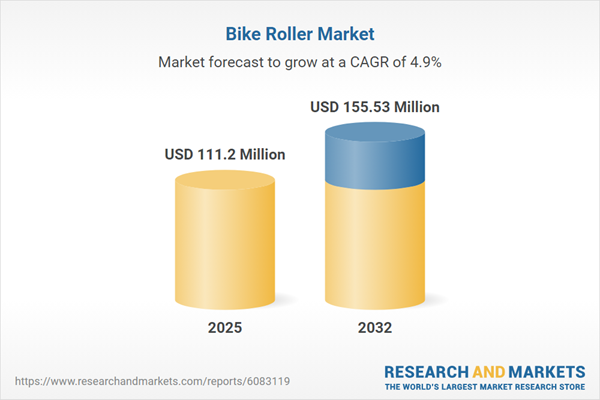Speak directly to the analyst to clarify any post sales queries you may have.
The Bike Roller Market is advancing rapidly as stakeholders drive innovation in indoor cycling solutions. This evolution is propelled by growing demand for digitally connected, sustainable, and adaptable training products optimized for diverse user requirements and dynamic regulatory climates.
Market Snapshot: Growth Trajectory of the Bike Roller Market
The bike roller market grew from USD 105.93 million in 2024 to USD 111.20 million in 2025 and is projected to reach USD 155.53 million by 2032, reflecting a CAGR of 4.91%. Sustained interest from both commercial and consumer segments—spanning training facilities, home users, and digital fitness communities—continues to stimulate adoption of innovative and robust products. This growth is supported by advancements in technology integration, evolving end-user preferences, and responsive supply chain strategies in an increasingly competitive landscape.
Scope & Segmentation of the Bike Roller Market
The report delivers granular insights across the full spectrum of the market, emphasizing multidimensional segmentation and regional nuances.
- Product Types: Direct drive rollers, fluid rollers, magnetic rollers, wind rollers
- Distribution Channels: Online retailers, specialty stores, sports retailers
- End Users: Gym facilities, rehabilitation centers, home users
- Connectivity Technologies: Ant+ Fe-C, Ant+ Standard, Ble, Classic Bluetooth, dual band Wifi, single band Wifi
- Regions: Americas — including United States, Canada, Mexico, Brazil, Argentina, Chile, Colombia, Peru; Europe, Middle East, and Africa — spanning United Kingdom, Germany, France, Russia, Italy, Spain, Netherlands, Sweden, Poland, Switzerland, UAE, Saudi Arabia, Qatar, Turkey, Israel, South Africa, Nigeria, Egypt, Kenya; Asia-Pacific — including China, India, Japan, Australia, South Korea, Indonesia, Thailand, Malaysia, Singapore, Taiwan
- Leading Companies: Garmin Tacx B.V., Wahoo Fitness LLC, Elite S.p.A., Saris Bicycle Company, Kinetic by Kurt LLC, Minoura Co. Ltd., JetBlack Limited, BKOOL spol s r.o., Feedback Sports Inc., CycleOps LLC
Key Takeaways for Senior Decision-Makers
- User adoption is largely shaped by enhanced training realism and ergonomic product design, meeting evolving athlete and home fitness needs.
- Smart rollers now function as critical nodes within broader digital fitness ecosystems. Integration with community-driven platforms and real-time analytics is accelerating market differentiation.
- Eco-conscious consumers are influencing manufacturers to invest in sustainable materials, recyclable components, and energy-efficient production processes.
- Adapting to local regulatory requirements and consumer habits in diverse global regions is vital for market penetration and long-term brand strength.
- Strategic alliances—especially with digital content providers and fitness influencers—are redefining engagement and opening new revenue channels for brands.
- Durability, modularity, and upgrade paths are key for catering to commercial clients and supporting aftermarket growth, particularly within gym and rehabilitation contexts.
Tariff Impact on Supply Chain & Profitability
US tariffs introduced in 2025 have prompted companies to reassess supplier networks and shift sourcing to alternative production hubs. These changes, designed to cushion firms from elevated input duties, triggered a strategic reorientation of pricing and supply chain management. Many businesses are strengthening regional partnerships and exploring nearshore assembly to counteract cost pressures and boost resilience. Ongoing dialogues with industry groups and regulators are shaping advocacy approaches and informing exemption strategies for emerging technologies.
Methodology & Data Sources
This market analysis combines structured interviews with C-level executives and product directors, along with end-user validation across primary segments. Secondary research includes technical documentation, regulatory records, and sector-specific publications. Quantitative modeling incorporates shipment and pricing data, using regression and variance analysis, while expert-led validation workshops ensure reliable and actionable conclusions.
Why This Report Matters for Strategic Decision-Makers
- Enables data-driven resource allocation through detailed product and technology segmentation, helping stakeholders prioritize innovation investment and market entry planning.
- Supports risk mitigation by clarifying regional and tariff-related supply chain dynamics and regulatory environments that can impact profitability and operational continuity.
- Provides a clear competitive landscape, revealing opportunities for partnership development and competitive positioning based on sustainability and digital integration goals.
Conclusion: Navigating Market Evolution
The bike roller market is defined by ongoing shifts in user demand, technological convergence, and adaptive supply chain models. Strategic innovation, operational flexibility, and sustainable practices will underpin lasting growth and provide a stable platform for competitive advancement in indoor cycling solutions.
Table of Contents
3. Executive Summary
4. Market Overview
7. Cumulative Impact of Artificial Intelligence 2025
Companies Mentioned
The companies profiled in this Bike Roller market report include:- Garmin Tacx B.V.
- Wahoo Fitness, LLC
- Elite S.p.A.
- Saris Bicycle Company
- Kinetic by Kurt, LLC
- Minoura Co., Ltd.
- JetBlack Limited
- BKOOL, spol. s r.o.
- Feedback Sports, Inc.
- CycleOps LLC
Table Information
| Report Attribute | Details |
|---|---|
| No. of Pages | 188 |
| Published | October 2025 |
| Forecast Period | 2025 - 2032 |
| Estimated Market Value ( USD | $ 111.2 Million |
| Forecasted Market Value ( USD | $ 155.53 Million |
| Compound Annual Growth Rate | 4.9% |
| Regions Covered | Global |
| No. of Companies Mentioned | 11 |









